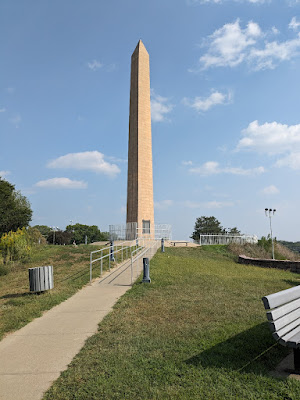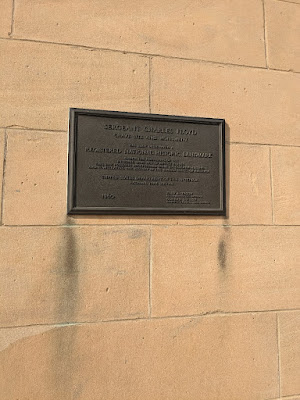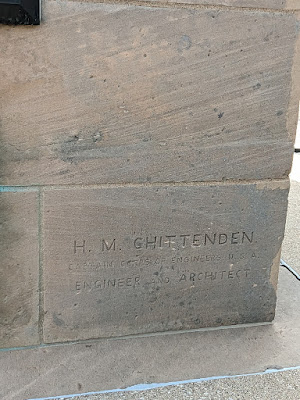At first glance, Sioux City, Iowa, might seem like a strange place for a 100-foot tall, Egyptian-style sandstone obelisk. But the first National Historic Landmark is one of Sioux City's most recognizable landmarks, with deep ties to local and national history. Here's what families should know about the Floyd Monument:
Where is the Floyd Monument?
The Floyd Monument is just off highway 75 a bit south and east of downtown Sioux City, on a bluff overlooking the Missouri River. The official address is 2601 S. Lewis Boulevard. There is a parking lot at the monument with ample free parking.
History of the Floyd Monument
The Floyd Monument is a 100-foot sandstone obelisk built as a tribute to
Sergeant Charles Floyd, the only member of Lewis & Clark's Corps of
Discovery Expedition to die on the expedition.
Sgt. Floyd was a non-commissioned officer who served as Quartermaster for the
first leg of the expedition. But after an illness, Sgt. Floyd died on August
20, 1804. Most modern scholars believe he died of appendicitis, based on his
symptoms as described in Floyd's diary and Clark's journals. You can learn
much more about Sgt. Floyd and about the expedition more generally at the
Lewis & Clark Interpretive Center along the Missouri Riverfront in
Sioux City.
The Corps of Discovery members buried Sgt. Floyd respectfully on the bluff,
1/2 mile from the river, but over time erosion caused the grave to be exposed,
so his grave was moved in 1857.
In 1894, Sgt. Floyd's diaries were published, and a renewed interest in him
became a fad amongst Gilded Age Siouxland society. Unfortunately, this
included negative interest as well as positive, and thieves stole his
headstone. But in 1895, Floyd was moved for a second time and an association
was formed to build a more permanent memorial for Sgt. Floyd. The Floyd
Association raised $20,000, quite a sum at the time, and in 1900, the concrete
base for the monument was poured in May and a 3' by 7' marble cornerstone was
placed in August. Floyd was reinterred yet again, with the association hoping
this would be a more final resting place for the explorer.
The monument itself was built of sandstone from the Kettle River area in
Minnesota and was completed on May 30, 1901. The monument was designed by
Engineer Captain Hiram M. Chittenden, who was rewarded with a 13-volume set of
books of The Life and Works of Francis Parkman. Chittenden was part of
the U.S. Army Corps of Engineers, and Congress paid for and approved him to
work on the monument as architect and engineer without cost to the Floyd
Memorial Association.
In 1903, a model of the Floyd Monument was displayed by the U.S. Army Corps of
Engineers at the St. Louis World's Fair.
On June 30th, 1960, the Sergeant Floyd Monument was designated by the U.S.
Department of the Interior as the first National Historic Landmark. Today
there are more than 2,500 National Historic Landmarks across the nation and
overseas, including 26 others in Iowa, 22 in Nebraska, and 16 in South Dakota.
Other National Historic Landmarks in Siouxland include the Sgt Floyd Welcome
Center in Sioux City, the Woodbury County Courthouse in Sioux City, the
Kimball Village archaeological site in Westfield, IA, and the Dr. Susan
LaFlesche Picotte Memorial Hospital in Walthill, NE
Visiting the Sergeant Floyd Monument
The Floyd Monument and surrounding 23-acre park grounds are free and open to
the public. There are bathrooms located near the street in a cinderblock
building, and there are some picnic tables. The grounds include interpretive
signage, flags, and spectacular views of the Missouri River basin. There is supposedly at least one geocache on the grounds, but I was not able to find it (I am literally the worst at geocaching and also can't find the one right by my house, so read nothing into this, haha.)
The Floyd Monument is currently managed by the Sioux City Public Museum
**Extra caution recommended: It is possible to get to dangerous parts of the
bluff, where you would literally die if you tumbled down, so I definitely
recommend extra caution with toddlers and preschoolers, and recommend against
letting kids, even early elementary age who could normally be given a bit more
leeway, roam without a parent.
Events at the Floyd Monument
The Floyd Monument is used by local reenactors for an annual Sgt. Floyd
burial encampment each August and is a participating site in the Wreaths
Across America program, which places wreaths on the graves of and monuments
to fallen US military at more than 3,500 sites around the USA each year
during the Christmas season.
Find out more about the Sergeant Floyd Monument
To learn more about the Sgt. Floyd Monument, visit the
Floyd Monument page on the National Parks Service website, or
the Floyd Monument page on the Sioux City Public Museum website.
To learn more about Sgt. Charles Floyd, I definitely recommend a visit to the
Lewis & Clark Interpretive Center, where you'll find an animatronic Sgt.
Floyd and lots of information about his life and death, as well as information
about the other members of the Corps of Discovery and their historic
Expedition. Check out
my guide to the Lewis & Clark Interpretive Center
for more info about the museum.

.png)




Comments
Post a Comment
Thanks for joining in the conversation! We can't wait to hear what you have to say. Some comments are moderated, so it may take some time for your comment to appear on the site. We encourage lively discussion, but will delete comments that are hostile, hateful, spammy, or rude.